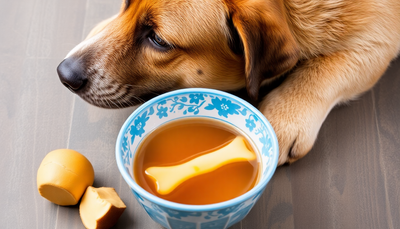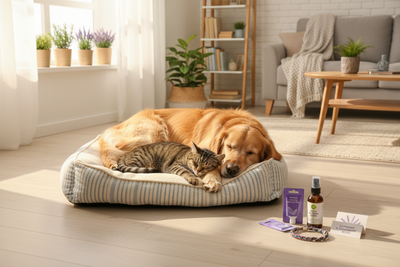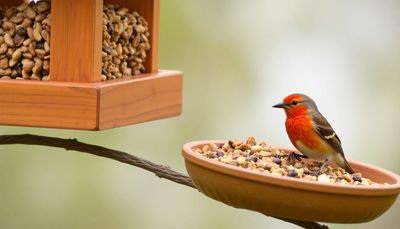The Pet Parent's Dilemma: Choosing the Right Flea Solution
As a devoted pet parent, few challenges are as persistent as protecting your furry family members from fleas. These tiny parasites can transform your peaceful home into an uncomfortable environment for both you and your pets. When faced with an infestation, the question inevitably arises: should you reach for chemical solutions with proven track records or explore natural alternatives that promise gentler care? This pet flea treatment guide aims to help you navigate this important decision.
The battle against fleas involves balancing effectiveness with safety concerns, understanding treatment options, and creating a comprehensive approach that aligns with your values and your pet's specific needs. Whether you have a playful pup who enjoys romping through tall grass or an indoor cat with sensitive skin, finding the right flea prevention strategy is essential for their comfort and health.
Let's explore both chemical and natural treatment options, examining their benefits, limitations, and how they might fit into your pet care routine. By the end of this guide, you'll be equipped with the knowledge to make informed decisions that keep your beloved companions comfortable and pest-free.
Understanding Chemical Flea Treatments
Chemical flea treatments have dominated the market for decades, offering pet owners reliable solutions for controlling and eliminating flea infestations. These products come in various forms, including topical spot-on treatments, oral medications, collars, sprays, and shampoos. Their popularity stems from their proven effectiveness and convenience, but understanding how they work and their potential drawbacks is crucial for responsible pet ownership.
Effectiveness vs. Safety Concerns
Most conventional flea treatments contain active ingredients like fipronil, imidacloprid, permethrin, or pyrethroids that target the nervous systems of fleas, effectively paralyzing and killing them. These chemical solutions typically offer several advantages:
Quick action: Many chemical treatments begin working within hours, providing rapid relief for heavily infested pets.
Residual protection: A single application can offer protection lasting from one to three months, depending on the product.
Broad-spectrum control: Many formulations target multiple parasites simultaneously, including ticks, mites, and internal parasites.
However, these benefits come with potential concerns that every pet owner should consider:
Toxicity risks: Some pets may experience adverse reactions ranging from mild skin irritation to more serious neurological symptoms. Cats are particularly sensitive to certain chemicals like permethrin, which is safe for dogs but potentially fatal for felines.
Environmental impact: Chemical residues can affect beneficial insects, contaminate waterways, and persist in the environment.
Long-term exposure concerns: Some research suggests possible links between chronic exposure to certain pesticides and health issues in both pets and humans.
Resistance development: Over time, flea populations can develop resistance to commonly used chemicals, reducing their effectiveness.
Dr. Karen Becker, a proactive wellness veterinarian, notes that while chemical treatments are sometimes necessary, "the cumulative toxic load these chemicals place on your pet's liver and other organs of detoxification is concerning, especially for animals with existing health challenges."
When selecting a chemical treatment, always consult with your veterinarian to find options appropriate for your pet's age, health status, and specific needs. Never use dog products on cats or vice versa, as species-specific formulations account for different metabolic processes and sensitivities.
Natural Flea Treatment Alternatives
For pet owners concerned about chemical exposure or those seeking more environmentally friendly options, natural flea treatments offer alternative approaches to pest management. These solutions draw from traditional remedies, plant-based ingredients, and mechanical control methods to address flea problems with potentially fewer side effects.
Herbal Solutions and Their Efficacy
Natural flea remedies typically incorporate ingredients that repel or kill fleas through less toxic mechanisms. Popular options include:
Essential oils: Certain oils like cedarwood, lavender, eucalyptus, and lemongrass have demonstrated repellent properties against fleas. However, proper dilution is critical, as concentrated oils can be harmful to pets, especially cats whose livers cannot effectively process many essential oils.
Diatomaceous earth (food grade): This powdery substance works mechanically rather than chemically, dehydrating fleas by damaging their exoskeletons. It can be lightly dusted on pet bedding and carpets, though care should be taken to avoid inhalation.
Apple cider vinegar: While not directly lethal to fleas, diluted apple cider vinegar sprays may help make your pet's skin less hospitable to fleas due to its pH-altering effects.
Herbal flea collars: Homemade or commercially available collars infused with herbs like rosemary, thyme, and neem oil can provide some repellent action.
Flea-repelling plants: Growing certain plants like lavender, mint, and rosemary in your garden or near pet areas may help reduce flea populations naturally.
The efficacy of these natural solutions varies significantly. Research from the University of California found that while some essential oils do demonstrate repellent properties, their effects are typically shorter-lasting than chemical alternatives, often requiring more frequent application. Additionally, natural doesn't always mean safe; some plant-based substances can cause skin irritation or toxicity if improperly used.
Veterinarian Dr. Judy Morgan, who specializes in integrating holistic practices with conventional veterinary medicine, suggests: "Natural treatments often work best as part of a comprehensive approach rather than standalone solutions. They're most effective for prevention and maintenance rather than addressing severe infestations."
When exploring natural options, look for products with clear ingredient lists and specific dosing instructions. Avoid DIY recipes without veterinary guidance, as improper concentrations can harm your pet. Remember that pregnant animals, very young puppies and kittens, and pets with certain health conditions may have special considerations when using any treatment, including natural ones.
Creating a Holistic Flea Prevention Plan
The most successful approach to flea control combines multiple strategies tailored to your pet's lifestyle, your home environment, and the severity of the flea problem. A comprehensive plan addresses all stages of the flea life cycle and creates multiple barriers against infestation.
Combining Methods for Maximum Protection
An effective holistic flea prevention strategy incorporates these key elements:
Regular monitoring: Check your pet frequently for signs of fleas, especially during warm months or after visits to areas where other animals gather. A flea comb run through your pet's fur can help detect problems early.
Consistent grooming: Bathing your pet with a gentle, pet-safe shampoo helps remove adult fleas mechanically. Even plain water can drown many fleas, though it won't prevent reinfestation.
Environmental management: Since adult fleas spend most of their time off your pet, thorough home cleaning is essential:
Vacuum carpets, furniture, and crevices frequently, disposing of vacuum bags promptly
Wash pet bedding in hot water weekly
Consider treating your yard, especially shaded areas where pets rest
Limit access to wildlife areas where fleas may be abundant
Dietary support: Some pet owners report success with nutritional approaches like adding small amounts of garlic (for dogs only, never cats) or brewer's yeast to food, though scientific evidence for their effectiveness is limited. A balanced, high-quality diet supports your pet's immune system, potentially making them less attractive to parasites.
Targeted treatment rotation: To prevent resistance development, consider rotating between different treatment methods or using complementary approaches. For example, you might use a chemical treatment during peak flea season and natural preventatives during lower-risk periods.
Professional guidance: Regular veterinary check-ups allow for monitoring and adjusting your flea control strategy based on your pet's changing needs and local flea activity patterns.
Veterinary parasitologist Dr. Michael Dryden recommends thinking of flea control as "integrated pest management" rather than seeking a single perfect solution. "The goal is to create multiple obstacles for fleas at different life stages, making it difficult for them to establish a population in your home or on your pet."
For pets with flea allergies or those living in heavily infested areas, your veterinarian might recommend combining a reliable chemical treatment with environmental controls and supplementary natural repellents. This multi-faceted approach often provides the most comprehensive protection while potentially allowing for lower doses of chemical products.
Making the Right Choice for Your Pet
When deciding between natural and chemical flea treatments, there's no one-size-fits-all answer. The best approach depends on your individual circumstances, including your pet's health status, your local flea pressure, and your personal values regarding chemical use.
Consider these factors when making your decision:
Infestation severity: For heavy, established infestations, chemical treatments typically provide faster relief. Natural methods may be more suitable for prevention or maintaining control after an infestation has been addressed.
Pet-specific factors: Age, health conditions, species, and breed can all influence treatment safety. Very young, elderly, pregnant, or ill animals may require special consideration.
Environmental context: Urban pets with limited outdoor access face different risks than rural animals or those frequently visiting dog parks and wilderness areas.
Your comfort level: Your own values regarding environmental impact and chemical exposure should factor into your decision-making process.
Remember that flea control is rarely a "set it and forget it" situation. Regular reassessment and adjustment of your approach will likely be necessary as seasons change, your pet ages, or new products become available.
Finding Your Balance: The Integrated Approach
Both natural and chemical flea treatments offer distinct advantages depending on your pet's specific needs and your particular situation. Many veterinarians now recommend an integrated approach that draws from both worlds, using the most appropriate tools at the right times while minimizing unnecessary chemical exposure.
A thoughtful flea prevention strategy prioritizes your pet's comfort and health above all else. Whether you choose primarily natural methods, rely on conventional treatments, or blend both approaches, consistency and vigilance remain your best allies in the ongoing battle against fleas.
Consider consulting with your veterinarian to create a tailored approach that addresses your specific concerns and circumstances. With proper planning and informed choices, you can keep your beloved companions comfortable, healthy, and flea-free while respecting your values and preferences as a responsible pet parent.






